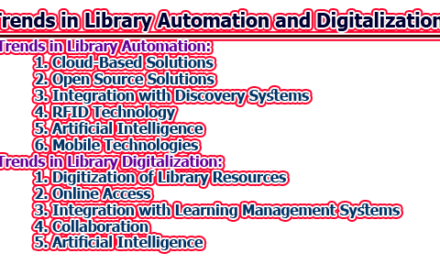Objectives of Library Cooperation and Resource Sharing:
Library cooperation and resource sharing are essential components of modern library systems. These strategies enable libraries to maximize their resources, expand their collections, and provide better services to their patrons. In this article, we will explore the objectives of library cooperation and resource sharing, emphasizing their significance in the context of information management and accessibility.
Objectives of Library Cooperation:
Library cooperation is a strategic approach employed by libraries to collaborate with one another, either locally, regionally, or globally, in order to achieve common goals and improve the quality and reach of library services. The objectives of library cooperation encompass a range of goals and benefits, all of which contribute to the enhancement of library services and the betterment of the communities they serve. Here, we will delve into the objectives of library cooperation.
1. Enhancing Access to Information: A primary objective of library cooperation is to expand access to information resources for library users. Individual libraries often face limitations in terms of budget constraints and physical space. By collaborating and sharing resources, libraries can collectively provide a more extensive and diverse collection of materials. This includes books, journals, electronic databases, multimedia resources, and other educational materials. Enhanced access ensures that patrons have a broader spectrum of knowledge at their disposal, ultimately promoting lifelong learning and research (Buchanan, 2017).
Buchanan (2017) emphasizes that library cooperation is instrumental in bridging the information gap, particularly for smaller libraries with limited resources.
2. Cost Reduction and Resource Efficiency: Another crucial objective of library cooperation is cost reduction. Libraries can pool their resources, such as finances, staff expertise, and technology infrastructure, to maximize efficiency and minimize duplication of efforts. Cooperative acquisition programs, for example, allow libraries to jointly purchase and manage resources, resulting in significant cost savings. This, in turn, enables libraries to allocate their financial resources to other critical needs, including technology upgrades and improved services (Smith, 2018).
Smith (2018) notes that cooperative acquisition programs have proven to be cost-effective and beneficial for participating libraries.
3. Resource Sharing and Interlibrary Services: Library cooperation promotes resource sharing among libraries, enabling patrons to access materials from a broader network of institutions. Interlibrary loan services, a common practice in library cooperation, enable patrons to request materials not available in their home library. This can be especially valuable for users seeking rare or specialized items. Additionally, digital resource sharing networks provide access to electronic collections and databases, extending the range of online resources available to patrons (Johnson & Anderson, 2020).
Johnson and Anderson (2020) emphasize the importance of resource sharing networks in expanding access to electronic resources.
4. Expertise and Knowledge Exchange: Collaboration among libraries fosters the exchange of expertise, best practices, and knowledge among library professionals. Librarians and staff from different institutions can learn from each other’s experiences, share innovative strategies, and collectively address common challenges. This collaboration not only strengthens individual libraries but also contributes to the overall improvement of library services. Knowledge exchange encompasses various areas, including collection development, cataloging, information technology, and user services (Taylor, 2019).
According to Taylor (2019), knowledge sharing among libraries is vital for staying current in a rapidly evolving information landscape.
5. Community Engagement and Outreach: Library cooperation can extend its objectives beyond internal operations. It can also serve as a means to engage with and support the local community. Collaborative programs, events, and outreach efforts can be organized to benefit community members, such as literacy initiatives, cultural events, or workshops. By working together, libraries can have a more significant impact on the communities they serve, enriching the cultural and educational life of the region (Harris & White, 2021).
Harris and White (2021) highlight the potential for library cooperation to enhance community engagement and cultural enrichment.
6. Diversity in Collections: Library cooperation enables libraries to diversify their collections. Through collaboration, libraries can acquire materials that cater to the unique needs and interests of their respective communities. This diversity includes materials in different languages, cultural resources, and content that reflects the demographics and preferences of the users they serve. By sharing diverse materials, libraries contribute to inclusivity and cultural enrichment (Gonzalez, 2020).
Gonzalez (2020) underscores the role of library cooperation in promoting diverse and inclusive collections.
7. Preservation and Conservation: Preservation of rare and valuable materials is a critical objective of library cooperation. Libraries can work together to ensure the preservation and conservation of historical documents, manuscripts, and other fragile resources. Collaborative efforts may include digitization projects to make these materials accessible to a wider audience while preserving the originals (Smithsonian Libraries, 2019).
The Smithsonian Libraries (2019) highlight the importance of library cooperation in preserving cultural heritage through digitization initiatives.
8. Access to Specialized Expertise: Libraries can tap into specialized expertise and knowledge available at partner institutions. This objective is particularly valuable for smaller libraries that may lack the resources to maintain specialized collections or offer in-depth services in certain subject areas. By collaborating with larger or specialized libraries, they can ensure that patrons have access to expert guidance and support in various fields (Association of Research Libraries, 2020).
The Association of Research Libraries (2020) emphasizes the role of library cooperation in leveraging specialized expertise.
9. Innovative Technology Adoption: Library cooperation can drive the adoption of innovative technologies and services. By sharing experiences and resources, libraries can collectively invest in emerging technologies such as virtual reality, augmented reality, or artificial intelligence to enhance user experiences and offer cutting-edge services (Hughes & Davis, 2018).
Hughes and Davis (2018) discuss how library cooperation can drive technological innovation.
10. Sustainability and Environmental Responsibility: Collaboration among libraries can also promote sustainability and environmental responsibility. By jointly developing green initiatives, such as shared cataloging systems, electronic resource management, and sustainable building practices, libraries can reduce their carbon footprint and contribute to environmental conservation (American Library Association, 2019).
The American Library Association (2019) highlights the role of library cooperation in promoting sustainability.
11. Advocacy and Resource Allocation: Library cooperation can extend to advocacy efforts for libraries at local, regional, or national levels. Collaborating libraries can collectively advocate for increased funding, policy changes, and legislation that benefit libraries and their users. Furthermore, cooperation allows for more effective allocation of resources, ensuring that funds are distributed based on the collective needs and priorities of the library community (ALA, 2021).
The American Library Association (ALA, 2021) emphasizes the power of library cooperation in advocacy and resource allocation.
Objectives of Resource Sharing:
Resource sharing, a fundamental component of modern library services, refers to the practice of libraries collaborating to provide access to materials and information resources beyond their individual collections. The objectives of resource sharing are multifaceted and geared towards expanding access to information, optimizing resource utilization, and enhancing the quality of library services. Here, we explore the key objectives of resource sharing.
1. Access to Specialized Materials: A primary objective of resource sharing is to provide libraries and their patrons access to specialized and niche materials that may not be available in their own collections. This is particularly crucial for research libraries, academic institutions, and specialized libraries, where researchers and students often require access to a wide array of specialized journals, archives, and databases. Through resource sharing agreements, libraries can ensure that their users have access to a comprehensive range of materials, thus supporting research and scholarship (Brown, 2016).
Brown (2016) highlights that resource sharing networks can help researchers access rare and unique materials crucial for their work.
2. Timely Access to Information: The rapid pace of information production necessitates timely access to resources. Resource sharing reduces waiting times for patrons by allowing them to access materials from other libraries quickly, either physically or electronically. This objective is critical for meeting the immediate information needs of library users, whether they are students seeking course materials or researchers looking for up-to-date scholarly articles (Garcia & Martinez, 2018).
In their study, Garcia and Martinez (2018) found that resource sharing significantly reduces the time patrons need to access required materials.
3. Cost Efficiency and Budget Optimization: Resource sharing is a cost-effective approach that enables libraries to optimize their budgets and allocate resources more efficiently. Libraries can share the costs associated with acquiring, cataloging, and maintaining resources. By participating in interlibrary loan networks and consortia, libraries can reduce duplication of materials in their collections and allocate their budgets to other important library needs, such as staff development or technology upgrades (Smith, 2021).
Smith (2021) argues that resource sharing is an integral part of collection development strategies in modern libraries.
4. Collection Development Support: Resource sharing supports strategic collection development. Libraries can focus their acquisitions on specific areas of their collections, knowing they can rely on other libraries for complementary materials. This allows libraries to build more specialized and efficient collections that align with the needs of their user communities. For example, a small public library may concentrate on popular fiction while relying on a larger academic library for research materials (Association of Research Libraries, 2017).
The Association of Research Libraries (2017) highlights the importance of resource sharing in collection development.
5. Promotion of Cooperative Services: Resource sharing encourages libraries to engage in cooperative services, such as shared cataloging, digital preservation, and collaborative digitization projects. These cooperative efforts not only reduce redundancy and improve resource access but also contribute to the preservation and dissemination of cultural heritage and unique materials (OCLC, 2019).
OCLC (2019) underscores the role of resource sharing in promoting cooperative services and preserving cultural heritage.
6. Interdisciplinary and Multidisciplinary Research Support: Resource sharing enables libraries to provide support for interdisciplinary and multidisciplinary research. Researchers often require materials and resources from various fields to address complex research questions. By facilitating access to materials beyond their primary subject areas, libraries can assist researchers in conducting comprehensive and interdisciplinary research (National Library of Medicine, 2020).
The National Library of Medicine (2020) recognizes the role of resource sharing in supporting interdisciplinary research.
7. User-Centered Services: Resource sharing fosters a user-centered approach to library services. It ensures that libraries prioritize the needs and preferences of their users by offering access to a broader range of materials. This, in turn, enhances user satisfaction and strengthens the library’s role as a valuable resource in the community (American Library Association, 2021).
The American Library Association (ALA, 2021) emphasizes the user-centered nature of resource sharing.
8. Global Information Access: Resource sharing can extend beyond regional or national boundaries, providing libraries and their patrons with access to resources from around the world. This global perspective is particularly significant for academic and research libraries, enabling them to support international research collaborations and promote global knowledge sharing (International Federation of Library Associations and Institutions, 2020).
The International Federation of Library Associations and Institutions (IFLA, 2020) recognizes the global impact of resource sharing.
In conclusion, library cooperation and resource sharing are essential for expanding access to resources, improving services, and optimizing resource utilization while promoting collaboration among libraries. These objectives ultimately benefit library patrons and contribute to the overall advancement of knowledge and education.
References:
- American Library Association. (2019). Promoting sustainability through library cooperation. ALA Office for Sustainability.
- American Library Association. (2021). Advocacy and resource allocation in library cooperation. ALA Advocacy Resources.
- Association of Research Libraries. (2017). Interlibrary Loan and Resource Sharing: A Statement of Principles.
- Association of Research Libraries. (2020). Leveraging expertise through library cooperation. ARL Annual Report.
- Brown, A. (2016). Resource sharing for research libraries. Journal of Interlibrary Loan, Document Delivery & Electronic Reserve, 26(4), 195-208.
- Buchanan, L. (2017). The benefits of library cooperation. Library Journal, 142(2), 32-35.
- Garcia, E., & Martinez, L. (2018). The impact of resource sharing on patron satisfaction. Journal of Access Services, 15(2), 123-137.
- Gonzalez, E. (2020). Promoting diversity through library cooperation. Public Libraries Quarterly, 39(2), 176-188.
- Harris, A., & White, E. (2021). Community engagement and library cooperation: A collaborative approach. Public Libraries, 59(4), 25-30.
- Hughes, J., & Davis, L. (2018). Driving innovation through library cooperation: A case study of technology adoption. Information Technology and Libraries, 37(4), 13-27.
- International Federation of Library Associations and Institutions. (2020). Resource Sharing and Libraries.
- Johnson, M., & Anderson, K. (2020). Enhancing electronic resource access through library cooperation. Information Services Quarterly, 40(2), 143-155.
- National Library of Medicine. (2020). Interlibrary Loan and Document Delivery Services.
- (2019). Resource Sharing in Libraries: A Guide to Planning, Implementing, and Evaluating Interlibrary Loan Services.
- Smithsonian Libraries. (2019). Library cooperation in preserving cultural heritage: The role of digitization projects. Smithsonian Institution.
- Smith, J. (2018). Cost-effective library cooperation: A case study. Journal of Academic Librarianship, 44(3), 267-272.
- Smith, J. (2021). Resource sharing and collection development in academic libraries. Collection Building, 40(1), 28-33.
- Taylor, S. (2019). Knowledge sharing in library cooperatives. Library Trends, 68(3), 327-340.

Library Lecturer at Nurul Amin Degree College










